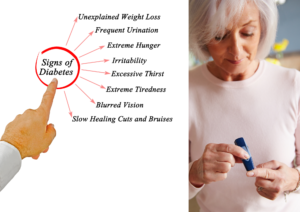Diabetes is a chronic condition that can develop gradually, often without obvious symptoms at first. However, early detection is crucial for managing the disease and preventing complications. Knowing the warning signs of diabetes can help you seek medical advice promptly, allowing for early treatment and better long-term outcomes.
This article will explore the early signs of both Type 1 and Type 2 diabetes, how to recognize them, and what steps you can take to protect your health.
1. Frequent Urination (Polyuria)
One of the earliest and most common signs of diabetes is frequent urination, particularly at night. This occurs because excess glucose (sugar) in the blood causes the kidneys to work harder to filter and remove the extra glucose. As a result, more urine is produced, leading to frequent bathroom trips. If you or someone you know is urinating more often than usual, it could be an indication of high blood sugar levels.
2. Increased Thirst (Polydipsia)
With frequent urination comes increased thirst, a condition known as polydipsia. The body loses more fluids through urine, prompting a need to drink more water to stay hydrated. If you find yourself constantly thirsty, even after drinking plenty of fluids, this could be an early warning sign of diabetes.
3. Unexplained Weight Loss
Unexpected weight loss, particularly in people who are not trying to lose weight, can be an early indicator of diabetes, especially Type 1 diabetes. When the body is unable to produce enough insulin or use it effectively, it begins to break down muscle and fat for energy, leading to significant weight loss. If you notice rapid weight loss without any obvious cause, it’s important to consult a healthcare professional.
4. Extreme Fatigue
Feeling unusually tired, even after getting enough rest, is another common early sign of diabetes. The body relies on glucose for energy, but when insulin levels are insufficient or ineffective, the cells cannot absorb glucose properly. This lack of energy can cause persistent fatigue, making daily activities more challenging.
5. Blurred Vision
High blood sugar levels can cause changes in the fluid levels in the eyes, leading to swelling and blurred vision. If left untreated, this can eventually damage the blood vessels in the eyes, increasing the risk of serious vision problems, including diabetic retinopathy. If you experience sudden or frequent episodes of blurred vision, it’s essential to have your blood sugar levels checked.
For more information on diabetes-related eye issues, visit the American Diabetes Association.
6. Slow Healing Wounds and Frequent Infections
People with diabetes often experience slower healing times for cuts, bruises, and wounds. High blood sugar levels can damage nerves and blood vessels, impairing circulation and making it harder for the body to repair itself. Additionally, people with diabetes may experience frequent infections, particularly skin and urinary tract infections, due to weakened immune function.
If you notice that minor cuts or wounds are taking longer than usual to heal, or if you are experiencing frequent infections, it could be an early sign of diabetes.
7. Tingling or Numbness in Hands and Feet
High blood sugar can damage nerves, particularly in the extremities, causing tingling, numbness, or a “pins and needles” sensation in the hands and feet. This condition is known as diabetic neuropathy and can be a warning sign of diabetes or prediabetes. If you experience these symptoms, it’s essential to consult a healthcare professional for further evaluation.
For more resources on managing diabetes-related complications, check out the Juvenile Diabetes Research Foundation (JDRF).
8. Increased Hunger (Polyphagia)
Another common early sign of diabetes is increased hunger, known as polyphagia. When the body cannot properly use glucose for energy, it signals the brain that it needs more fuel, leading to constant hunger, even after eating. If you notice that you’re always hungry, particularly if this is paired with unexplained weight loss, it may be an indication of diabetes.
9. Dark Patches of Skin (Acanthosis Nigricans)
Acanthosis nigricans is a condition in which dark, velvety patches of skin appear, often in the folds of the neck, armpits, or groin. This condition can be an early sign of insulin resistance, which is a precursor to Type 2 diabetes. If you notice unusual darkening of the skin, it’s important to discuss this with your healthcare provider.
Next Steps if You Spot Early Signs of Diabetes
If you or someone you know is experiencing any of these early signs of diabetes, it’s crucial to seek medical advice as soon as possible. A healthcare professional can perform tests, such as fasting blood glucose levels or an HbA1c test, to determine whether diabetes is present.
Early diagnosis and treatment are key to managing diabetes effectively and reducing the risk of complications. Lifestyle changes, such as adopting a balanced diet, increasing physical activity, and maintaining a healthy weight, can also help manage blood sugar levels and improve overall health.
Additionally, having access to diabetes supplies, such as blood glucose monitors and test strips, is essential for managing the condition. If you have extra diabetic supplies, consider selling them through Test Strip Search to help others access the tools they need for effective diabetes management.








